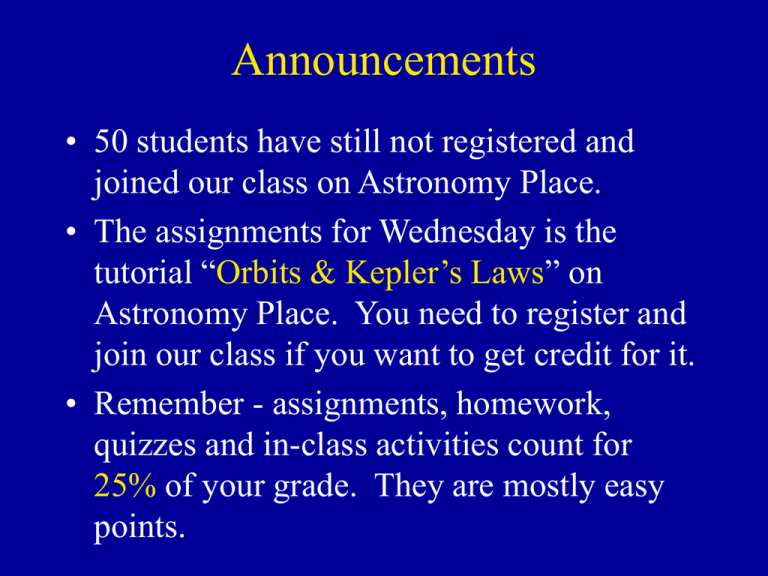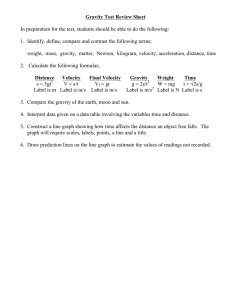Announcements
advertisement

Announcements • 50 students have still not registered and joined our class on Astronomy Place. • The assignments for Wednesday is the tutorial “Orbits & Kepler’s Laws” on Astronomy Place. You need to register and join our class if you want to get credit for it. • Remember - assignments, homework, quizzes and in-class activities count for 25% of your grade. They are mostly easy points. More Announcements • Quiz and Review - Monday Feb 9 • 1st Mid-Term Exam - Wednesday Feb 11 Will cover chapters 1-6 Objectives: Energy & Motion (from syllabus) • State the nature of Energy • Describe the different types of energy • Describe and apply the concept of conservation of energy • Describe the structure of an atom • Describe the relation between temperature and motion • Identify concepts: velocity, acceleration, momentum, force, mass Objectives (continued) • Describe the cause-effect relation between force & motion (Newton’s law of motion) Illustrate it by concrete examples. • Describe the relation between matter (mass), distance & gravity (Newton’s law of gravity) • Apply the theories of motion & gravity to explain astronomical & everyday phenomena • Use Newton’s version of Kepler’s 3rd law to determine the mass of astronomical bodies What have we learned? Matter and Energy: Matter - material, composed of atoms, electrons, … Energy – makes matter move, can do work! Atom electron nucleus p+n proton neutron e- Three Basic Types of Energy • kinetic – energy of motion • potential – stored energy • radiative – energy transported by light Energy is CONSERVED! Transferred, transformed, NOT created or destroyed KE + PE + RE = total energy = constant 2 E=mc Mass and Energy are the same thing, measured in different units (e.g. kg & joules) hot pot has more mass than a cold one you have more mass when running fast Motion • speed – rate at which an object moves, i.e. the distance traveled per unit time [m/s; mi/hr] • velocity – an object’s speed in a certain direction, e.g. “10 m/s moving east” • acceleration – a change in an object’s velocity, i.e. a change in either speed or direction is an acceleration [m/s2] • momentum -- (mass x velocity), oomph Newton’s Theory of Motion Acceleration = Force / Mass Force = push or pull Mass = resistance to force (inertia), depends on amount of matter, not size Acceleration = change in velocity, speed up, slow down, turn Memorize this equation Orbital Motion • Direction of planets motion continually changes (speed changes slightly for most and drastically for Mercury & Pluto) Need a FORCE • Planet’s motion is ACCELERATED (direction and speed change) Force is needed. Newton said FORCE is GRAVITY Newton’s Theory of Gravity • Source of Gravitational Force is MASS Every object attracts every other object by the force of gravity. • More Mass stronger gravity • Larger Distance weaker gravity Fgravity = G M m / D2 Force Number For units Mass 1 mass 2 Distance Tests • • • • Know acceleration = F/m at Earth’s surface Know distance to Moon Calculate acceleration at Moon’s distance Compare to acceleration found from Moon’s period and distance • Does this prove Newton’s theories of motion and gravity are correct? Yes? / No? Activity: orbital motion Problems of Heliocentric Model • Objects fall straight down • Atmosphere and Moons stay with planets Uranus & Neptune • Laplace (1800) calculated Uranus orbit from effects on other planets Its ONLY a THEORY • Newton’s theories of motion and gravity were used to predict the locations of Uranus and Neptune which astronomers then looked and found with telescopes • Newton’s theories of motion and gravity are used to plot the orbits of spacecraft, comets and asteroids. • Newton’s theories of motion and gravity are used to determine the masses of astronomical bodies. Philosophy • Mechanical Universe Given knowledge of where everything is and how it is moving now (and enough computer power) can calculate everything that will happen in the future! • Do you like this idea? Appeal • Universal all motion, terrestrial as well as celestial • Accurate predictions • Aesthetically pleasing simple, few assumptions, explains lots Application: Masses • From a=F/M2 and F=GM1M2/D2 get Newton’s version of Kepler’s 3rd law 4 D V P M1 M 2 2 G P 2G 2 3 3 Don’t memorize this formula If can measure period and either separation or speed of two astronomical bodies orbiting each other can determine the sum of their masses. Is it correct? • Discrepancies: – orbit of Mercury – high speeds (e.g. cyclotron) • Improved Theory – Einstein’s theory of Motion & Gravity (Relativity) Mass warps space-time Warped space-time tells masses how to move What is a FACT & what is a THEORY? Think about it! Assignment for Wednesday • Wednesday - Chapter 6 Light (& matter) • Assignment for Wednesday Feb. 4, tutorial “Orbits & Kepler’s Laws” on Astronomy Place To get credit you must both register & join our class • Problems with Astronomy Place - clear browser cache & try again (instructions linked to course web page and on Angel)



